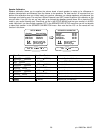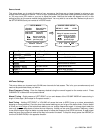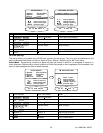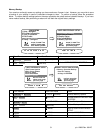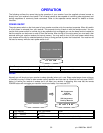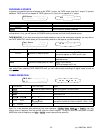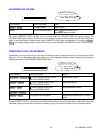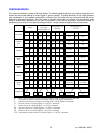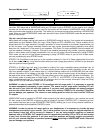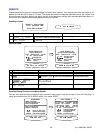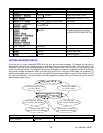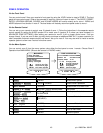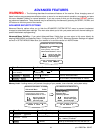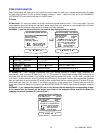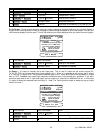
Surround Modes (cont.)
DVD Source Com
p
osite Video
DVD PCM 2.0 Pro Lo
g
ic
step to desired mode
(MODE)
MODE
ActionFrom Front PanelFrom Remote
Note: your receiver keeps track of a surround mode for each of the sources. It would be possible, for example, to
have your DVD player set to SURROUND while your CD player is set to STEREO. All you need to do is change
sources and the surround mode you last used for that source will be recalled. HEADPHONE mode, unlike the
other surround modes, applies to all sources. This allows you to change sources while remaining in HEADPHONE
mode. When you leave HEADPHONE mode, each source will return to the SURROUND mode that was previously
active for that source.
Why do I need all these modes?
Many people will be happy leaving their receiver in SURROUND mode all the time. Your receiver will automatically
switch back and forth between Dolby Pro Logic, Dolby Digital and DTS (AVR202 only). Stereo material will be
played back with Pro Logic decoding. ProLogic’s extraction of mono information to the center channel works just
as well on stereo (non-ProLogic encoded) material and may provide improved imaging, especially when sitting
away from the “sweet spot” in the center of your speakers. Only Dolby Pro Logic encoded 2-channel material has
true rear speaker information. However, ProLogic’s rear speaker processing may provide a pleasing ambiance
effect on many stereo (non-ProLogic) soundtracks. You can turn off center channel processing by using STEREO
HALL mode, you can turn off rear channel processing by using 3 STEREO mode, or you can turn off both center
and rear processing by using STEREO mode.
STEREO F/R (F
ront/Rear) mode puts you in the orchestra instead of in front of it. Some people prefer this mode
for all their stereo listening. It may also be useful when you have a large group where it is difficult to put everyone
near the optimum listening position.
STEREO Lt Rt (R
ight total Left total) is provided for making Pro Logic compatible analog recordings from all
sources including Dolby Digital and DTS. Your tape outputs contain the same audio information as your left and
right front speaker outputs. If you make a tape in a normal listening mode such as SURROUND then the center
and rear information will not appear on the tape. Since the center channel contains much of the dialog for movies,
the tape will be almost useless. STEREO Lt Rt mode allows you to make a tape with little loss of information. You
can’t directly make an analog tape of Dolby Digital 5.1 or DTS 5.1, but STEREO Lt Rt will produce a Dolby Pro
Logic compatible tape from 5.1 sources that will preserve much of the surround information. Note that Dolby
Digital will mix LFE at 10dB below normal level in this mode.
WARNING: in order to make STEREO Lt Rt recordings with full range audio, it is necessary to override
the bass management processing in your receiver. This means that full range audio (including LFE) will
also be sent to your front left and right speakers. If you have small front speakers we strongly suggest
you turn the volume down or even mute the volume while making STEREO Lt Rt recordings. Otherwise
you can damage your speakers. The volume or mute setting does not effect the level from the TAPE and
V1 outputs.
HEADPHONE mode is identical to STEREO mode except that the internal amplifiers in your receiver are turned
off. Also, some of the CONTROL outputs may also be turned off (typically CONTROL OUT 1) depending on how
your receiver has been set up (see ADVANCED FEATURES), allowing you to turn off any external amplifiers or
powered subwoofers with compatible CONTROL inputs.
WARNING: in order to provide full range audio to your headphones, it is necessary to override the bass
management processing in your receiver. This is not a problem if you are using the internal amplifiers in
your receiver since they will be turned off. However, if you are using external amplifiers or powered
speakers with no CONTROL OUT capability then full range audio (including LFE for DTS) will also be sent
to your front left and right speakers. If you have small front speakers we strongly suggest you manually
turn off your external amplifiers or powered speakers before
switching to HEADPHONE mode. Otherwise
you can damage your speakers.
36
p/n 12699 Rev. 9812C



